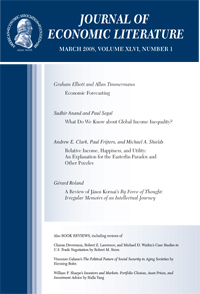研究生心理健康:美国经济学系的经验教训
IF 11.5
1区 经济学
Q1 ECONOMICS
引用次数: 41
摘要
我们通过临床验证的调查,研究了美国八个顶尖经济学博士项目研究生的心理健康状况。我们发现,24.8%的人出现中度或重度抑郁或焦虑症状,是人群平均水平的两倍多。尽管我们的应答率为45.1%,并且存在样本选择问题,但保守的下限表明此类症状的患病率高于普通人群。心理健康问题在博士课程结束时尤其普遍:36.7%的六年级以上学生出现中度或重度抑郁或焦虑症状,而一年级学生的这一比例为21.2%。在有这些症状的经济学学生中,25.2%的学生正在接受治疗,而在其他项目的研究生中,这一比例为41.4%。同样比例的经济学学生(40-50%)表示,他们不能诚实地与顾问讨论心理健康问题,就像他们不能轻易地与他们讨论非学术职业选择一样。只有26%的人发现自己的工作总是或在大多数时候都是有用的,相比之下,70%的经济学教师和63%的劳动年龄人群认为自己的工作是有用的。我们为学生、教师和管理人员提供改善研究生心理健康的建议。(JEL A23,I12,I18,I23)本文章由计算机程序翻译,如有差异,请以英文原文为准。
Graduate Student Mental Health: Lessons from American Economics Departments
We study the mental health of graduate students at eight top-ranked economics PhD programs in the United States using clinically validated surveys. We find that 24.8 percent experience moderate or severe symptoms of depression or anxiety—more than two times the population average. Though our response rate was 45.1 percent and sample selection concerns exist, conservative lower bounds nonetheless suggest higher prevalence rates of such symptoms than in the general population. Mental health issues are especially prevalent at the end of the PhD program: 36.7 percent of students in years 6+ of their program experience moderate or severe symptoms of depression or anxiety, versus 21.2 percent of first-year students. Of economics students with these symptoms, 25.2 percent are in treatment, compared to 41.4 percent of graduate students in other programs. A similar percentage of economics students (40–50 percent) say they cannot honestly discuss mental health with advisers as say they cannot easily discuss nonacademic career options with them. Only 26 percent find their work to be useful always or most of the time, compared to 70 percent of economics faculty and 63 percent of the working age population. We provide recommendations for students, faculty, and administrators on ways to improve graduate student mental health. (JEL A23, I12, I18, I23)
求助全文
通过发布文献求助,成功后即可免费获取论文全文。
去求助
来源期刊

Journal of Economic Literature
ECONOMICS-
CiteScore
17.80
自引率
0.80%
发文量
49
期刊介绍:
Commencing in 1969, the Journal of Economic Literature (JEL) serves as a vital resource for economists, offering a means to stay informed about the extensive literature in the field. Each JEL issue features commissioned, peer-reviewed survey and review articles, book reviews, an annotated bibliography categorizing new books by subject, and an annual index of dissertations from North American universities.
 求助内容:
求助内容: 应助结果提醒方式:
应助结果提醒方式:


